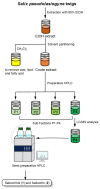Anti-Adipogenic Effects of Salicortin from the Twigs of Weeping Willow (Salix pseudolasiogyne) in 3T3-L1 Cells
- PMID: 36296558
- PMCID: PMC9609119
- DOI: 10.3390/molecules27206954
Anti-Adipogenic Effects of Salicortin from the Twigs of Weeping Willow (Salix pseudolasiogyne) in 3T3-L1 Cells
Abstract
Salix pseudolasiogyne (Salicaceae), the "weeping willow," has been used in traditional Korean medicine to treat pain and fever due to its high concentrations of salicylic acid and salicin. The present study investigated bioactive compounds from S. pseudolasiogyne twigs to discover bioactive natural products. Phytochemical investigation of the ethanol (EtOH) extract of S. pseudolasiogyne twigs followed by liquid chromatography-mass spectrometry (LC/MS)-based analysis led to the isolation of two salicin derivatives, salicortinol and salicortin, the structures of which were determined by interpretation of their NMR spectra and data from the LC/MS analysis. To the best of our knowledge, this is the first report of salicortinol isolated from S. pseudolasiogyne. The isolated compounds were evaluated for their anti-adipogenic effects in 3T3-L1 cells. Both salicortinol and salicortin were found to significantly inhibit adipocyte differentiation in 3T3-L1 cells. In particular, salicortin exhibited a strong inhibitory effect on lipid accumulation. Furthermore, salicortin inhibited the expression of lipogenic and adipogenic transcription factors, including FASN, FABP4, C/EBPα, C/EBPβ, and PPARγ, without inducing cytotoxicity. These results suggest that salicortin could be a potential therapeutic compound for the prevention or treatment of metabolic disorders such as obesity.
Keywords: 3T3-L1 cells; Salix pseudolasiogyne; adipocyte differentiation; lipid metabolism; salicortin.
Conflict of interest statement
The authors declare no conflict of interest.
Figures





References
MeSH terms
Substances
Grants and funding
LinkOut - more resources
Full Text Sources
Research Materials
Miscellaneous

